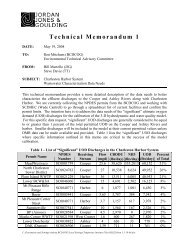Town of Summerville Planning Area - BCD Council of Governments
Town of Summerville Planning Area - BCD Council of Governments
Town of Summerville Planning Area - BCD Council of Governments
- No tags were found...
Create successful ePaper yourself
Turn your PDF publications into a flip-book with our unique Google optimized e-Paper software.
considered to be in compliance under the current federal air quality regulations. However, if stricterstandards for air quality were passed in the near future, the region’s compliance would be imperiled.South Carolina and Charleston continue to enjoy some <strong>of</strong> the best air quality in the US. This is due, inpart, to the ocean breezes that help to sweep away ozone, particulate matter, and carbon monoxide.Updated air quality standards are currently being proposed at the federal level that would lower themaximum amounts <strong>of</strong> ozone in the air. If this occurs, the new regulations may require mitigationmeasures to take place across the metro Charleston region. Local governments are currentlyconsidering a number <strong>of</strong> mitigation measures related to transportation and industrial impacts to theregion’s air quality to achieve this objective.All three counties in the metro Charleston region are participating in a voluntary Early Action Compactprogram administered by the US Environmental Protection Agency. In this program, participating areashelp to determine what actions can be taken at the state and local levels to ensure compliance withfederal ozone standards before the federal deadline to do so.The Living EnvironmentWildlife, Habitat, and VegetationTable NR2 is an updated list <strong>of</strong> the federal and state endangered and threatened species <strong>of</strong> wildlife andvegetation that are present in the <strong>Summerville</strong> <strong>Planning</strong> <strong>Area</strong>.Invasive SpeciesWhile many plant species that are non‐native to the Lowcountry have benefitted <strong>Summerville</strong> over theyears, including the azaleas that decorate many <strong>of</strong> the streets and parks within <strong>Summerville</strong>, other plantand animal species have become a concern to residents <strong>of</strong> the metro Charleston region. While many <strong>of</strong>these species were introduced accidentally into the local ecosystem through shipping activities at thePort <strong>of</strong> Charleston and other US ports, others were intentionally introduced to the area. Some invasiveplant species were introduced for ornamental use in area gardens, while other (mostly animal) specieswere introduced in order to control the population <strong>of</strong> so‐called nuisance pests. Because <strong>of</strong> a variety <strong>of</strong>factors, including a lack <strong>of</strong> natural local predators and the ability to <strong>of</strong> these species thrive in theconditions present in <strong>Summerville</strong> and other areas <strong>of</strong> South Carolina, many invasive species havebecome a threat to the natural ecosystem <strong>of</strong> the Lowcountry. Invasive plant and animal species havedamaged local ecosystems, eliminating key habitat areas for native animals and starving nativevegetation <strong>of</strong> resources, including water and sunlight. Every effort should be made for residents andbusinesses to continue to eradicate these species. A listing <strong>of</strong> invasive plant and animal species that maybe present in the <strong>Summerville</strong> <strong>Planning</strong> <strong>Area</strong> is included as Table NR3.Natural Resources Element Page 5




